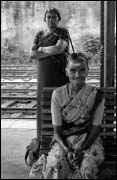Bodies in Motion (29 page)
Authors: Mary Anne Mohanraj
1983:
Thirteen soldiers are killed in an LTTE ambush, sparking anti-Tamil riots which led to the deaths of an estimated several hundred Tamils. Conflict develops in the north between the army and LTTE.
1987:
Government forces push the LTTE back into the northern city of Jaffna. The government signs accords creating new councils for Tamil areas in the north and east of the country and reaches agreement with India on deployment of an Indian peacekeeping force.
1990:
Indian troops leave after getting bogged down in fighting in the north. Violence escalates.
2000:
Norway says it will act as an intermediary in a push for peace.
2001:
Britain labels the LTTE “terrorists” under a new antiterrorism law designed to halt funding and support for UK-based militant groups.
2002 (February):
The government and the LTTE sign a permanent cease-fire agreement, paving the way for talks to end the long-running conflict. The peace initiative is sponsored by Norway.
2002 (December):
During peace talks in Norway the government and the LTTE agree to share power. Under the deal, minority Tamils would have autonomy in the mainly Tamil-speaking north and east.
2004 (July):
A suicide bomb blast Colomboâthe first such incident since 2001âraises fears for the fragile peace process.
2004 (December):
More than thirty thousand people are killed when massive waves generated by a powerful undersea earthquake off the coast of Indonesia devastate coastal communities. Hundreds of thousands are forced from their homes. The government declares a national disaster.
2005 (June):
A deal is reached with the LTTE to share nearly three billion dollars in tsunami aid among Sinhalas, Tamils, and Muslims. The Sinhala nationalist JVP party pulls out of the governing coalition in protest.

I hadn't been back to Sri Lanka in many years, due mostly to civil unrest in the country. But I was determined to make a trip after the publication of
Bodies in Motion
. The following essay about my trip back is from a work in progress.
Â
“Don't worryâyou can pass,” she said, her voice low, her hand reassuring on my arm.
I'd just finished reading from my new book,
Bodies in Motion,
at SALA, the South Asian Literature Association academic group. A pretty, dark-skinned woman had walked up to me; her nose was pierced and she looked much like many of the women I had seen the last time I was in Sri Lanka nine years before. Of course, she could have been South Indian instead. I couldn't tell the difference between a Sri Lankan and an Indian on sight. We started talking about my upcoming trip to Sri Lanka. She hadn't been back since she was a little girl; she was Tamil too. Her family had emigrated to India during the troubles. As a teenager she'd wanted desperately to get her nose pierced. Her father would only allow it if she promised him she would never go back to Sri Lanka. With her nose pierced she could never pass for Sinhalese.
“It had been more than two years since the cease-fire, but the memory of two decades of civil unrest was still vivid in the minds of expatriates like my father.”
My own father had worried about this trip. He told me over and over again to stay with the white tourist groups, with the hotel guides, and to never go anywhere by myself. Not even to temples, not even in the daytime. It had been more than two years since the cease-fire between the Tamil Tigers and the Sinhalese government, but the memory of two
decades of civil unrest (the “troubles”) was still vivid in the minds of expatriates like my father.
In 1983, I was twelve and was going to go back by myself to spend a summer with my grandparents. A few days before I was to get on a plane my father received a telegram from SriLanka.
Don't send her; there's trouble coming.
He cancelled my flight. At the beginning of July there came word of major riots in Colombo, the capitalâof thousands of Tamils dead, killed by their Sinhalese neighbors.
That month marked the start of almost two decades of civil unrest. Many Tamils (those who could afford to) abandoned their homes, their friends, and their country. They flew to India, Canada, England, Australia, Americaâwherever someone might be willing to speak for them, to take them in. My aunts started arriving in the States, one after another; it wasn't long before my mother's eight siblings had all come to America or Canada.
In 2002, after extended peace talks in Oslo mediated by the tireless Norwegians, a cease-fire was negotiated between Prabhakaran, the leader of the Tamil Tigers, and President Kumaratunga. The cease-fire had held, unlike others before it, and so in 2005 I planned to go back to Sri Lanka. To research, to remember.
"My parents were Sri Lankan Tamils, but I couldn't speak Tamil, couldn't tell a Tamil from a Sinhalese on the street. What did being Tamil have to do with me?”

Now that the cease-fire had held for a few years, I'd persuaded my father that it would be safe enough for me to go back. To be honest, I thought his concerns were overstated, overwrought. I was a permanent resident in America; I had lived there for thirty-one of my thirty-three years. My parents were Sri Lankan Tamils, true, members of the minority group, but I couldn't speak Tamil, couldn't tell a
Tamil from a Sinhalese on the street. What did being Tamil have to do with
me
?
And yet here was this woman, at an academic conference in Philadelphia on a winter's night in December, telling me that, yes, I could pass.
I didn't know what she meant. Was it my light skin that would protect me? Would the features of my face not reveal me as Tamil? I couldn't tell the difference myself, though either of my parents could often tellâby glancing at a face or overhearing a few wordsânot only whether someone was Tamil or Sinhalese, but also which city or village they were from. I was blind and deaf to such nuances; raised in America, I could tell a Southern accent from a Boston accent, but that wouldn't be much use to me in Sri Lanka. Did it matter? I was just going to be there for a few weeks, as a tourist.
I protested. I explained that I couldn't speak Tamil
or
Sinhalese. I wanted to say I was an American.
She just insisted:
You'll be fine; you can pass. Just keep your mouth shut and smile.
Sri Lankan Curry Powder
1 cup coriander seeds
½ cup cumin seeds
1 tablespoon fennel seeds
1 rounded teaspoon fenugreek (methi) seeds
1 cinnamon stick, about
2 inches long
1 rounded teaspoon whole cloves
1 rounded teaspoon cardamom seeds
2 tablespoons dried curry leaves
2 rounded teaspoons red chili powder
- In a dry pan over medium heat, separately roast the coriander, cumin, fennel, and fenugreek, stirring constantly until each becomes a fairly dark brown. Do not attempt to save time by roasting them togetherâthey each have different cooking times and you will only end up half-cooking some and burning others.
- Put the roasted herbs into a blender container (I use a coffee grinder that is dedicated solely to spice grinding) together with the cinnamon stick broken in pieces, the cloves, cardamom, and curry leaves.
- Blend the mixture at high speed until finely powdered. Sieve into a bowl, discarding any large pieces, and combine with the chili powder. Stir well. Store in an airtight jar.

An Excerpt from Mary Anne Mohanraj's Forthcoming Novel,
The Arrangement
E
VERY NIGHT
when she was a little girl, Shefali's father would tell her a story before bed. He was an English professor, so he knew the best stories. She curled up in her bed, beneath the deep blue comforter her mother had embroidered with silver moons and stars, and her father told her adventure stories: Robinson Crusoe, Peter Pan, Tarzan. He told her mysteries starring the brilliant Sherlock Holmes. He told her fairy tales and folktales, small household stories and legends of epic wars.
The Iliad
took him most of the winter when Shefali was eight, and the
Mahabharata
ate up the autumn of her ninth year. But his favorites were the love stories, and Shefali's father told them again and again.
Prince Rama and Princess Sita; Tristan and Isolde; King Shahryar and Scheherezade; Romeo and Juliet; Arthur and Guinevere; Clever princesses and kindly princes; black-hearted rivals and foolish fathers. Her father said that sometimes the lovers would be parted for many years, but eventually, if they were pure-hearted, strong, and loyal, they would be reunited, for nothing could stand in the way of true love. And though Shefali fought to keep her eyes open so he would keep telling her stories forever, her heavy lids would inevitably slide shut. The last thing she would see before sleep was her mother leaning in the doorway, listening. The last thing she would hear was her father saying, “But no man has
ever loved any woman as much as I love your mother.” The last thing she felt was the soft brush of his lips, and then hers, across her forehead as she tumbled into sleep and dreams.
When she was thirteen, Shefali's father stopped reading her stories. It was a few more years before she read those stories for herself and discovered that her father had changed the endings; years before Shefali realized that most love stories had beautiful beginnings but tragic conclusions. Even in the stories, a pure heart, strength, and loyalty were not enough to save you.
Don't miss the next book by your favorite author. Sign up now for AuthorTracker by visiting www.AuthorTracker.com.

RAISE
FOR
Bodies in Motion
“
Bodies in Motion
is a graceful, nimble book. With great care and affection, Mohanraj finds both beauty and lamentations in the disquieting, but revelatory, clash between custom and assimilation, between everything that came before and all that lies ahead.”
â
Boston Globe
“
Bodies in Motion
, Mary Anne Mohanraj's debut book, is less a collection of stories than a series of snapshots, a highly colored album of two SriLankan families in America. Taken together, glossing and expanding on each other, they create a vivid portrait of families in flux, wandering back and forth over borders both geographic and cultural.”
â
Los Angeles Times
“Beautifully writtenâ¦. As sensuously fulfilling as the romantic escapades and rich curries in which Mohanraj's characters indulge.”
â
Orlando Sentinel
“Mohanraj's writing style is spare and piercing, and she exercises a sophisticated economy of language. Indeed, words left unspoken are not only a technique of Mohanraj's but a defining characteristic of the lives of her characters as wellâ¦. “Tightness in the Chest (Vermont, 1986)” provides excellent illustrations of Mohanraj's own terseness intertwining with that of a character.”
-
San Francisco Chronicle Book Review
“From the start, Mohanraj moves deftly between third and first person, male and female voices, and time periodsâ¦. These stories transcend time and space.”
â
Time Out
(New York)
“Mohanraj evokes a moving portrait of families searching for love and a place to call home.”
â
Publishers Weekly
“The interrelated but stand-alone stories cover two generations of two families in motion on different levels and with different agendas.”
â
Knoxville News-Sentinel
“Intricately interwoven stories featuring sensual language and surprising sexual twists.”
â
Kirkus Reviews
“Mohanraj offers readers great insights into her characters and has plenty of material to be mined in future works. Recommended.”
â
Library Journal
“A deftly intricate weaving of voices and generations. These stories are gorgeous, sexy, and, above all, stories of survival. A writer to watch!”
âKaren Joy Fowler, author of
The Jane Austen Book Club
“On a rare occasion, a collection of stories comes along that breaks rules, tears down barriers and is a joy to read.
Bodies in Motion
by Mary Anne Mohanraj is such a collectionâ¦. Some stories are vibrant and full of heat, others cool and containedâ¦. A seductive, inviting work built primarily upon strong women.”
â
India Currents
“Mohanraj's skill in expressing her characters' struggles is significant and apparent in their diverse reactions. Not only does she offer the images of young women caught between the security of the well-defined tradition of arranged marriage and the sometimes-frightening freedom of personal choice, she also presents the dilemma faced by the fathers of these women.”
â
ThisWeek
(Central Ohio)